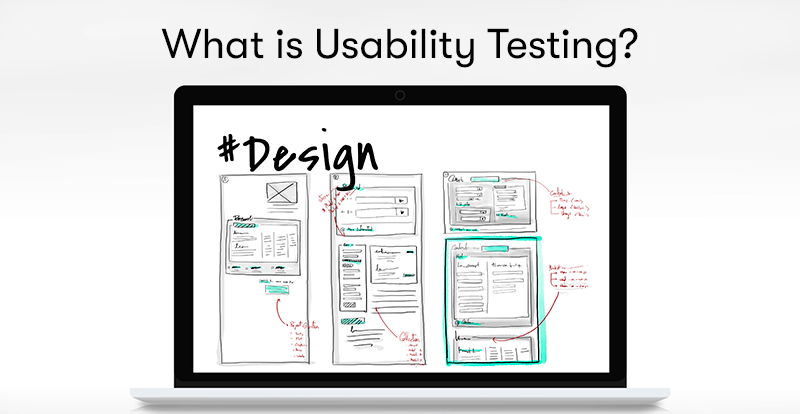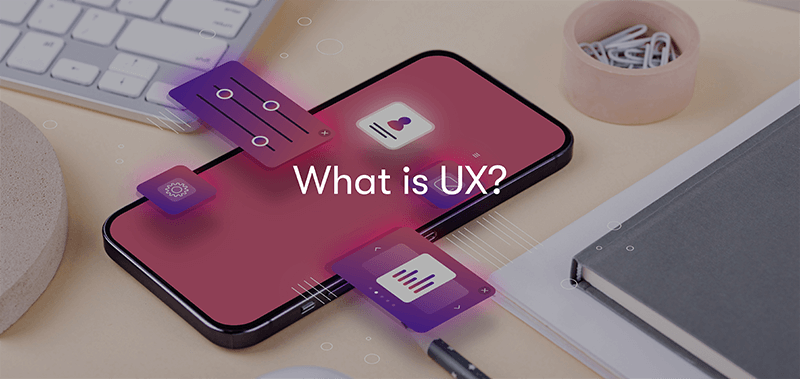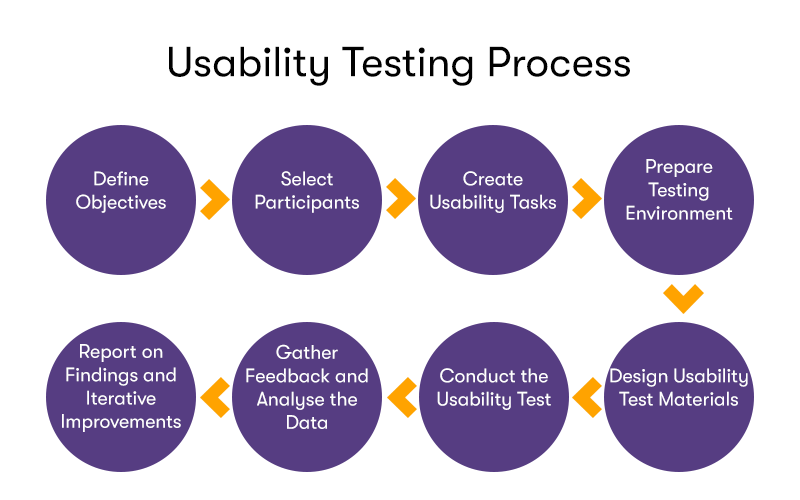What is Usability Testing in UX?
Usability Testing in UX (User Experience) is a crucial facet of crafting exceptional user experiences. Usability testing is a methodological cornerstone that empowers designers and developers to refine their creations by putting them in the hands of real users.
We will delve into the process, from planning and execution to analysis and iteration. We'll uncover how this invaluable tool helps identify usability issues, validate design assumptions, and create user-centred products. Along the way, we'll highlight the tangible benefits, including improved user satisfaction, reduced development costs, and competitive advantage.
What is Usability Testing?

Usability testing is a research method used in the field of user experience and human-computer interaction (HCI) to evaluate the usability and user-friendliness of a product, such as a website, software application, mobile app, or physical device. The primary goal of usability testing is to identify issues and areas for improvement in the design and functionality of a product from the perspective of its intended users.
Usability testing is a crucial step in the user-centred design process, as it helps ensure that a product is intuitive, efficient, and satisfying for its intended users. By uncovering usability issues early and making informed design changes, organisations can create products that better meet user needs and ultimately improve user satisfaction and success.
What is UX?

UX, or User Experience, refers to a person's overall experience when interacting with a product, service, system, or interface. It encompasses all aspects of the user's interaction, including their perceptions, emotions, behaviours, and attitudes while using a particular product or service.
Key components of UX include:
- Usability: The product or system should be easy to use, and users should be able to complete tasks efficiently and effectively.
- Utility: It should serve a purpose and fulfil the user's needs or goals. A product that doesn't meet users' needs is unlikely to provide a positive UX.
- Accessibility: The product should be accessible to a wide range of users, including those with disabilities, to ensure inclusivity.
- Desirability: Aesthetics, branding, and emotional design play a role in making the product attractive and engaging to users.
- Credibility: Users need to trust the product or service they're interacting with. Credibility is crucial for building and maintaining user trust.
- Value: Users should perceive value in the product or service, meaning it provides benefits that outweigh the costs or efforts required to use it.
- Efficiency: Users should be able to achieve their goals with minimal effort and time.
- Satisfaction: The overall experience should leave users feeling satisfied and positive about their interaction with the product or service.
UX design is an iterative process that involves understanding user needs, conducting research, designing interfaces or experiences, and continually testing and refining the product to ensure it delivers a positive user experience. UX designers often use various techniques and methods, such as user research, user personas, user journeys, wireframing, prototyping, and usability testing, to create products and services that are user-centric and user-friendly.
A well-designed user experience is essential for the success of products and services, as it can lead to increased user satisfaction, higher user retention, and improved brand reputation. It also helps in reducing user frustration and abandonment of products, which can lead to higher conversion rates and better business outcomes.
How is Usability Testing Used for UX Design?
Usability testing is a fundamental method in UX design that plays a crucial role in ensuring that products and services are user-friendly and aligned with user needs and expectations. Here's how usability testing is used in the UX design process:
Identifying User Pain Points
Usability testing helps uncover usability issues and pain points that users encounter when interacting with a product or service. This can include difficulties with navigation, confusing user interfaces, slow loading times, or unclear instructions. Identifying these issues early in the design process is essential for addressing them and improving the user experience.
Validating Design Assumptions
Designers often make assumptions about how users will interact with a product. Usability testing allows designers to validate these assumptions by observing how real users interact with the product. This can help prevent the development of features or designs that do not meet user needs.
Iterative Design
Usability testing is typically an iterative process. Designers conduct multiple rounds of testing, making design improvements between each round based on user feedback. This iterative approach ensures that the product continually evolves to become more user-friendly and effective.
User-Centred Design
Usability testing emphasises a user-centred design approach. It places users at the centre of the design process, ensuring that their feedback and needs guide design decisions. This approach results in products that are more likely to resonate with users and meet their expectations.
Quantitative and Qualitative Data
Usability testing provides both quantitative and qualitative data. Quantitative data, such as success rates, task completion times, and error rates, offers objective insights into user performance. Qualitative data, such as user comments and observations, provides rich context and helps designers understand the "why" behind user behaviour.
Prioritising Design Changes
Usability testing helps prioritise design changes by highlighting critical issues that need immediate attention. Designers can categorise issues based on their severity and impact on the user experience, allowing them to focus on the most pressing concerns first.
Cross-Functional Collaboration
Usability testing often involves collaboration between different teams, including designers, developers, and product managers. This collaboration fosters a shared understanding of user needs and encourages a multidisciplinary approach to solving usability issues.
Reducing Risk
By uncovering and addressing usability issues early in the design process, usability testing helps reduce the risk of costly redesigns and user dissatisfaction after a product is launched. It ultimately saves time and resources in the long run.
Continuous Improvement
Usability testing is not a one-time activity but an ongoing process. Even after a product is launched, usability testing can help identify areas for improvement and inform updates and enhancements.
What Are the Benefits of UX Usability Testing?

Usability testing in UX offers numerous benefits that contribute to the overall success of a product or service. Here are some of the key advantages:
Identification of Usability Issues
Usability testing helps uncover specific usability problems and pain points users encounter while interacting with a product. These issues can range from confusing navigation to unclear labelling, and their identification allows for timely resolution.
User-Centred Design
By involving real users in the testing process, usability testing ensures that the product's design aligns with the needs, preferences, and behaviours of the target audience. This user-centric approach leads to a more user-friendly and relevant product.
Improved User Satisfaction
A product that undergoes usability testing is more likely to provide a positive user experience. When users can easily accomplish their tasks, find information, and navigate without frustration, their satisfaction with the product increases.
Higher Conversion Rates
Usability testing can lead to design improvements that enhance the product's ability to convert users into customers or achieve other desired actions. Improving usability often leads to higher conversion rates for e-commerce sites, sign-up forms, and other user interactions.
Reduced User Errors
Usability testing helps identify and address areas where users commonly make mistakes or errors. By minimising these errors, usability improvements can enhance user productivity and task completion rates.
Increased User Engagement
Usability testing can reveal opportunities to engage users more effectively. For example, by simplifying the interface or enhancing the clarity of content, users may become more engaged with the product.
Cost Savings
Identifying usability issues early in the design process is more cost-effective than making extensive changes after the product has been developed and deployed. Usability testing helps catch problems before they become costly to fix.
Competitive Advantage
Products with superior usability often gain a competitive edge in the market. Usability can be a significant differentiator, attracting and retaining users who appreciate a smoother, more intuitive experience.
Data-Driven Decision Making
Usability testing generates empirical data about user behaviour and preferences. This data informs design decisions, allowing teams to prioritise changes based on user needs and evidence rather than subjective opinions.
Iterative Improvement
Usability testing is often conducted iteratively throughout the design and development process. Each round of testing informs improvements, leading to a product that continually evolves to meet user needs and expectations.
Enhanced Accessibility
Usability testing can uncover accessibility issues, ensuring that a product is usable by individuals with disabilities. Addressing these issues is not only a legal requirement but also a way to reach a broader audience.
User Loyalty and Advocacy
A positive user experience resulting from usability improvements can lead to user loyalty and advocacy. Satisfied users are more likely to recommend the product to others and remain loyal customers.
Reduced Support and Training Costs
When users can easily understand and use a product, there is less need for customer support and training. This can lead to reduced support costs and a more efficient use of resources.
In summary, usability testing is a valuable component of the UX design process because it helps create products and services that are more user-friendly, efficient, and aligned with user expectations. The benefits of usability testing extend to improved user satisfaction, higher conversion rates, cost savings, and a competitive advantage in the market.
How is Usability Testing Done?

Usability testing is typically conducted in several steps, from planning and preparation to execution and analysis. Here's an overview of how usability testing is done:
Define Objectives and Goals
- Clearly state the objectives and goals of the usability test. What do you want to learn or evaluate? What specific aspects of the product or interface are you interested in?
Select Participants (Testers)
- Identify the target user group or audience for your product or service.
- Recruit a diverse group of participants who represent the intended user base. Typically, 5-10 participants are sufficient to uncover the majority of usability issues.
Create Usability Tasks
- Develop a set of tasks or scenarios that participants will be asked to complete during the test. These tasks should align with your objectives and simulate real-world interactions with the product.
Prepare the Testing Environment
- Set up the testing environment, including the physical space (for in-person testing), necessary equipment (computers, mobile devices), and software or tools needed for recording or remote testing.
Design Usability Test Materials
- Prepare any materials or prototypes needed for the test, such as wireframes, interactive mock-ups, or functional prototypes.
- Create a test plan or script that outlines the test process, tasks, and instructions for participants.
Recruit and Schedule Participants
- Contact and schedule the selected participants for the usability test sessions.
- Provide participants with any necessary information about the test, including location (for in-person tests) or instructions for remote testing.
Conduct the Usability Test
- Begin each test session by welcoming the participant and explaining the purpose of the test. Emphasise that the test is not an evaluation of their skills but a way to gather feedback on the product.
- Instruct participants on how to use any equipment or software and explain the tasks they will perform.
- Encourage participants to think aloud as they complete tasks, sharing their thoughts, impressions, and any difficulties they encounter.
- Observe and take notes during the test, recording quantitative data (task success, time taken) and qualitative feedback (comments, observations).
- Facilitators should remain neutral and avoid leading participants or providing solutions during the test.
Debrief and Gather Feedback
- After each test session, debrief with the participant to collect additional feedback and impressions.
- Thank participants for their time and participation, and provide any incentives or compensation, if applicable.
Analyse Data and Identify Issues
- Review the data collected from all test sessions, including task success rates, completion times, and qualitative feedback.
- Identify common usability issues, pain points, and patterns across participants.
- Categorise issues based on severity and prioritise them for action.
Report and Recommendations
- Create a usability testing report summarising the findings and providing recommendations for improving the product's usability.
- Share the report with the project team, including designers, developers, and stakeholders.
Iterative Improvement
- Use the insights from usability testing to make necessary design changes and improvements to the product.
- Conduct additional rounds of usability testing as needed to validate the effectiveness of design changes.
Continuous Testing
- Usability testing is an ongoing process, and it can be valuable to conduct tests at various stages of product development to ensure ongoing improvements and alignment with user needs.
Usability testing is a user-centric, iterative process that informs design decisions and helps create products and services that provide a better user experience. The specific details of each usability test may vary depending on the project, but these steps provide a general framework for conducting effective usability testing.
What Different Types of Usability Testing Are There?
Usability testing employs various methods and approaches to evaluate the usability of a product. The choice of method depends on factors such as the type of product, available resources, and the specific research goals. Here are some standard usability testing methods:
Moderated Usability Testing
In-Person Moderated Testing: A facilitator guides users through test scenarios in a controlled environment, observes their interactions, and asks questions to gather feedback.
Remote Moderated Testing: Similar to in-person moderated testing, but conducted remotely using screen-sharing or video conferencing tools to facilitate user-facilitator communication.
Unmoderated Usability Testing
Remote Unmoderated Testing: Participants independently complete usability tasks while their interactions and feedback are recorded using specialised usability testing software. This method is cost-effective and allows for testing with a larger number of participants.
Hallway Testing: This informal method involves approaching people in a physical or virtual "hallway" (e.g., a public space or online community) and asking them to try the product on the spot. It provides quick, spontaneous feedback but may lack the structure of more formal tests.
Benchmark Testing
Benchmark usability testing compares the usability of a product against a benchmark or industry-standard usability metrics. It helps assess how a product's usability compares to competitors or established norms.
Cognitive Walkthrough
Testers, typically UX experts, go through the product step by step, evaluating its usability based on the user's perspective. They consider how users with various levels of experience would interact with the product and identify potential usability issues.
Heuristic Evaluation
A group of usability experts evaluates the product against a set of usability heuristics or guidelines (e.g., Nielsen's 10 usability heuristics). This method is useful for identifying usability problems but does not involve real users.
Card Sorting
Card sorting helps assess the information architecture and organisation of content. Participants are asked to group and categorise content or items into logical groups, revealing insights into how users expect to find information.
Tree Testing
Tree testing, also known as reverse card sorting, evaluates a website or application's findability and navigational structure by having participants perform specific tasks within a simplified text-based representation of the site's structure.
First Click Testing
Participants are asked to complete a task and click on what they believe is the most appropriate first link or option within the interface. This method helps identify navigation and labelling issues.
A/B Testing
While not a traditional usability testing method, A/B testing involves comparing two or more versions (A, B, etc.) of a product or feature with real users to determine which version performs better regarding user engagement, conversion rates, or other metrics.
Accessibility Testing
This type of testing focuses on evaluating the accessibility of a product for users with disabilities, ensuring that it complies with relevant accessibility standards (e.g., WCAG) and is usable by a diverse range of individuals.
Eye Tracking
Advanced eye-tracking technology monitors where users are looking on the screen, providing insights into visual attention and how users interact with specific elements.
Mobile Usability Testing
Tailored for mobile applications or websites, this method accounts for the unique challenges and user behaviours associated with mobile devices, such as touch interactions and varying screen sizes.
Guerilla Testing
Similar to hallway testing, guerilla testing involves approaching people in public spaces or online communities for quick, informal usability testing. It's typically conducted with minimal preparation and resources.
The choice of usability testing method should align with the research objectives, budget, and constraints of the project. Many organisations use a combination of these methods at different stages of product development to gather comprehensive usability insights and make informed design decisions.
Is UX Usability Testing Expensive to Carry Out?

The cost of conducting UX usability testing can vary widely depending on several factors, including the scope of the test, the number of participants, the complexity of the product, the location of the participants, and the tools and resources used. Here are some considerations that can impact the cost of usability testing:
- Number of Participants: The more participants you involve in the usability testing, the higher the cost. Usability testing is typically done with a small group of participants (usually between 5 and 10), but the exact number can vary based on your goals and budget.
- Participant Recruitment: Recruiting participants can be expensive, especially if you need to reach a specific and diverse user group. Compensation or incentives for participants may also add to the cost.
- Facilitator and Observer: If you choose a trained facilitator and observer for in-person or moderated remote testing, their time and expertise will contribute to the cost.
- Usability Testing Tools: Depending on your needs, you might require usability testing software, eye-tracking equipment, screen recording tools, or other technology to conduct the tests. These tools can vary in cost.
- Participant Incentives: Offering incentives or compensation to participants is common to encourage participation and to compensate them for their time and effort.
- Location and Facilities: If you conduct in-person usability testing, you may need to rent a testing facility, which comes with its associated costs.
- Prototype or Test Materials: Developing prototypes, wireframes, or test materials, especially for high-fidelity testing, can incur costs.
- Analysis and Reporting: The time and expertise required to analyse the data collected from usability testing and prepare a detailed report can add to the overall cost.
- Travel Expenses: If you need to travel to conduct usability testing or if participants are located in different geographic areas, travel expenses can increase the cost.
Iteration and Follow-up Testing: Conducting multiple rounds of usability testing for iterative improvements can extend the cost over time.
It's important to note that while usability testing does involve expenses, the benefits it provides in terms of improved user experience, reduced development costs (by catching issues early), and increased user satisfaction can outweigh these costs. Additionally, usability testing can be scaled to fit different budgets. For example, low-fidelity testing using paper prototypes or remote unmoderated testing can be more cost-effective than high-fidelity in-person moderated testing.
Many organisations view usability testing as a worthwhile investment in ensuring their products or services meet user needs and expectations, ultimately leading to better user retention and satisfaction. The cost of usability testing should be weighed against the potential long-term benefits and cost savings that result from creating more user-friendly and effective products.
Where Can You Learn More About UX?
Our BCS Foundation Certificate in User Experience training course is perfect for anyone who wants to increase their knowledge of User Experience. The BCS User Experience course will teach you the UX methodology, best practices, techniques, and a strategy for creating a successful user experience. The course will cover the following topics:
- Guiding Principles.
- User Research.
- Illustrating The Context of Use.
- Measuring Usability.
- Information Architecture.
- Interaction Design.
- Visual Design.
- User Interface Prototyping.
- Usability Evaluation.
Click the button below to find out more.

Final Notes On Usability Testing in UX?
In conclusion, usability testing is a cornerstone of effective UX design, allowing designers to uncover and address usability issues, validate assumptions, and create user-centred products. While costs can vary based on factors like participant numbers and testing methods, the benefits of improved user experience, reduced development expenses, and increased user satisfaction make it a worthwhile investment for businesses.
By following a systematic approach, from planning and participant selection to analysis and iteration, usability testing empowers teams to create products that resonate with users and stand out in today's competitive market. Embracing usability testing is not just an expense; it's an investment in the success of your user-centred projects.



